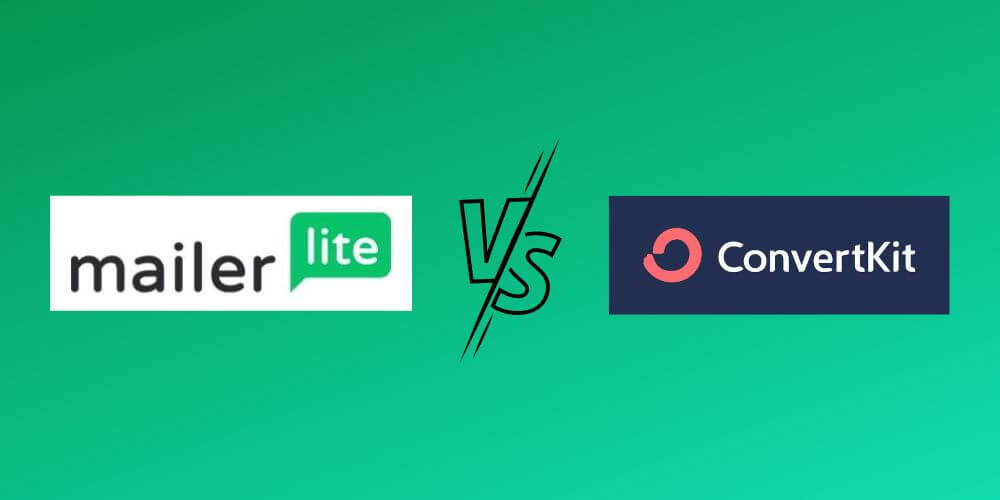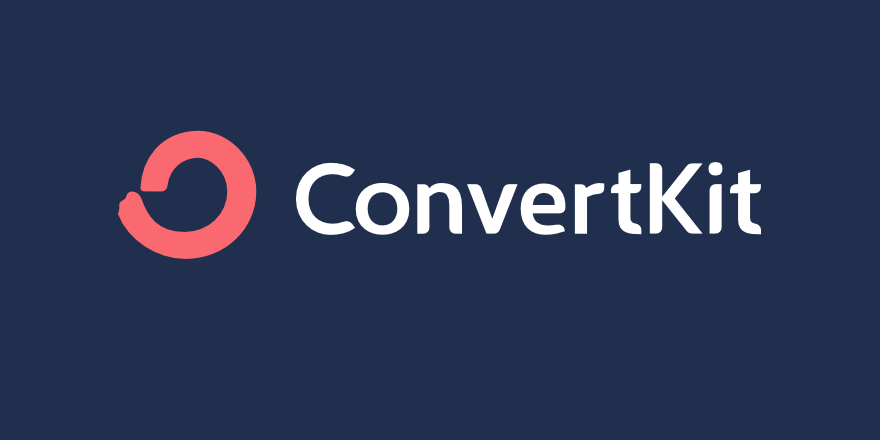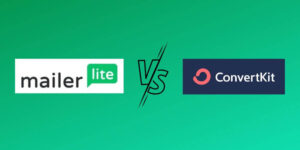Choosing the right email marketing platform is a critical decision for any business or creator looking to connect with their audience, nurture leads, and drive growth. In 2025, two prominent contenders in this space are MailerLite and ConvertKit. Both platforms offer a robust set of features designed to help users build email lists, create engaging campaigns, and automate their marketing efforts. However, they also have distinct strengths and weaknesses that cater to different user needs and preferences.

This in-depth comparison will delve into various aspects of MailerLite and ConvertKit, including their features, pricing, ease of use, automation capabilities, email deliverability, customer support, and more. By examining these key areas, we aim to provide you with a comprehensive understanding of both platforms to help you make an informed decision about which one is the better fit for your specific requirements in 2025.
1. Features: A Comprehensive Overview
Both MailerLite and ConvertKit offer a wide array of features to empower your email marketing endeavors. Let’s take a closer look at what each platform brings to the table:
MailerLite:
MailerLite positions itself as an all-in-one platform that makes it easy to create, send, and track email campaigns, build automated sequences, and manage subscriber lists. Its feature set is quite comprehensive and includes:
- Email Campaign Creation: Offers a user-friendly drag-and-drop editor, rich text editor, and custom HTML editor for creating visually appealing and effective email campaigns. It also provides a selection of newsletter templates to get you started quickly.
- Automation: Provides robust automation capabilities, allowing you to create multi-step email workflows triggered by various events like new sign-ups, email clicks, and more. Notably, it offers A/B testing for automation steps, enabling you to optimize your workflows for better results. It also supports RSS feed automation for creating campaigns from your latest website content.
- Subscriber Management: Features comprehensive subscriber management tools, including segmentation based on various criteria such as email interaction, survey answers, and more. It also allows for the creation of interest groups (subscriber tagging).
- Landing Pages and Websites: Enables you to build landing pages with custom domains and even create simple websites directly within the platform, expanding its functionality beyond just email marketing.
- Forms and Pop-ups: Offers various types of sign-up forms, including embedded forms and promotion pop-ups, to help you grow your subscriber list.
- Personalization and Dynamic Content: Supports personalization through the use of subscriber data and allows for the creation of dynamic content within emails to deliver tailored messages.
- Surveys and Quizzes: Includes features to create surveys and quizzes within your emails and landing pages to gather valuable information from your audience.
- E-commerce Campaigns: Provides specific features for e-commerce businesses to create targeted campaigns.
- Integrations: Offers a wide range of integrations with various third-party services.
- Reporting and Analytics: Provides reporting and analytics to track the performance of your email campaigns and automations.
ConvertKit:

ConvertKit is marketed as a powerful email marketing platform specifically built for creators, focusing on helping them grow their audience and sell their products. Its feature set emphasizes simplicity and effectiveness for this target audience.
- Email Campaign Creation: Offers an easy-to-use email builder with a focus on clean and simple design. While it might not have as many visual templates as MailerLite, it prioritizes deliverability and a straightforward writing experience.
- Automation: Provides robust and visual automation workflows, making it ideal for setting up complex sequences based on various triggers and actions. It excels in automation for creators looking to nurture leads and sell digital products. It also offers automation templates to help you get started.
- Subscriber Management: Features strong subscriber management capabilities with a focus on tagging and segmentation, allowing you to target specific audiences based on their actions and interests. It offers unlimited segmentation.
- Landing Pages and Forms: Enables you to create customizable landing pages and opt-in forms to capture leads.
- Personalization: Supports personalization within emails.
- Segmentation and Targeting: Offers advanced segmentation capabilities to target specific audiences effectively.
- E-commerce Integrations: Provides seamless integrations with popular e-commerce platforms to facilitate selling digital products and services.
- Reporting and Analytics: Offers reporting and analytics to track your email marketing performance.
Key Feature Differences:
While both platforms cover the essential aspects of email marketing, some key differences stand out:
- Visual Templates: MailerLite offers a broader range of pre-designed email templates compared to ConvertKit’s more minimalist approach.
- Advanced Automation Split Testing: MailerLite offers built-in A/B testing for automation steps, a feature that isn’t explicitly highlighted as a standard offering in ConvertKit’s basic plans.
- Landing Page and Website Builder: MailerLite includes a more comprehensive landing page builder and even a website builder, which are not the primary focus of ConvertKit, although ConvertKit does offer landing pages.
- Surveys and Quizzes: MailerLite has built-in survey and quiz creation features, which are generally not offered directly by ConvertKit, often requiring third-party integrations.
- Customization Options: MailerLite is noted to offer more customization options in some areas compared to ConvertKit.
2. Pricing: A Cost-Benefit Analysis
Pricing is a crucial factor for most users when choosing an email marketing platform. Let’s compare the pricing structures of MailerLite and ConvertKit:
MailerLite:

MailerLite is generally considered to be one of the more affordable email marketing platforms on the market, especially for users with smaller lists. It offers a transparent pricing structure based on the number of subscribers, with various tiers and a free plan for up to 1,000 subscribers with limited features. Their paid plans offer increasing features and subscriber limits at competitive prices. They also offer a 10% discount for users who opt for annual billing.
ConvertKit:
ConvertKit’s pricing is typically higher than MailerLite’s, especially as your subscriber list grows. They also offer a free plan with limited features, but their paid plans start at a higher price point and increase based on the number of subscribers. Their pricing is often justified by their focus on creators and their robust automation features.
Key Pricing Differences:
- Starting Price: MailerLite generally has a lower starting price for its paid plans compared to ConvertKit.
- Free Plan: Both offer free plans, but the features and subscriber limits may vary.
- Scalability: As your subscriber list grows, ConvertKit can become significantly more expensive than MailerLite.
- Value for Money: MailerLite is often perceived as offering more features for a lower price point, making it a strong contender for users on a budget. However, ConvertKit’s users often find its creator-focused features and automation capabilities justify the higher cost.
3. Ease of Use: Navigating the Platforms
The user-friendliness of a platform can significantly impact your efficiency and overall experience. Let’s compare the ease of use of MailerLite and ConvertKit:
MailerLite:
MailerLite is generally praised for its clean, intuitive, and user-friendly interface. Its dashboard is well-organized, making it easy to access the main features from the outset. The drag-and-drop email editor is intuitive and makes creating visually appealing emails straightforward. Setting up both the platform and automation workflows is relatively straightforward, and its jargon-free approach is often appreciated by new users.
ConvertKit:
ConvertKit also aims for user-friendliness, particularly for its target audience of creators. Its interface is clean and functional, although some might find MailerLite’s design slightly more visually striking. ConvertKit’s email builder is simple and focuses on a clean writing experience. Its automation builder is visual and quite robust, making it easy to set up complex sequences based on various triggers and actions.
Key Ease-of-Use Differences:
- Email Editor Intuition: While both are user-friendly, some reviews suggest MailerLite’s drag-and-drop email editor might be slightly more intuitive for designing visually rich emails.
- Dashboard Navigation: MailerLite’s dashboard is often cited for its clear and easy navigation.
- Automation Workflow Visualization: ConvertKit’s strength lies in its visual automation workflows, which can be particularly helpful for understanding and managing complex sequences.
- Learning Curve: Both platforms have relatively gentle learning curves, especially compared to more complex enterprise-level solutions. However, users new to email marketing might find MailerLite’s more comprehensive feature set slightly more to learn initially.
4. Automation: Powering Your Marketing Efforts
Email automation is a cornerstone of effective email marketing, allowing you to nurture leads, personalize communication, and streamline your workflows. Let’s compare the automation capabilities of MailerLite and ConvertKit:
MailerLite:
MailerLite offers powerful automation features that allow you to create multi-step email workflows triggered by a variety of events, including:
- New subscriber sign-ups
- Clicks on specific links in emails
- Completion of forms
- Specific dates
- Custom triggers via integrations
It supports features like:
- Delaying emails
- Adding conditional logic (if/then rules)
- Tagging subscribers based on their actions
- Moving subscribers between groups
- A/B testing automation steps
ConvertKit:
ConvertKit is renowned for its robust and visually intuitive automation capabilities, specifically designed for creators:
- Event-based triggers (e.g., joining a form, purchasing a product, clicking a link)
- Action-based steps (e.g., sending an email, adding a tag, starting another automation)
- Conditional content within emails
- Creating branches and personalized paths for subscribers
- Integration with e-commerce platforms for purchase-based automations
Key Automation Differences:
- Visual Workflow Builder: ConvertKit’s visual automation builder is often highlighted as a major strength, making it very easy to see and understand complex automation flows.
- Creator-Centric Automation: ConvertKit’s automation features are particularly well-suited for creators looking to sell digital products, courses, and memberships.
- Automation Split Testing: MailerLite explicitly offers A/B testing for automation steps, providing a built-in way to optimize your workflows. While ConvertKit allows for testing through other methods, it’s not as direct.
- Complexity Handling: Both platforms can handle complex automations, but ConvertKit’s visual builder can make managing intricate flows easier for some users.
5. Email Deliverability: Ensuring Your Messages Reach the Inbox
Email deliverability – the ability of your emails to reach your subscribers’ inboxes rather than their spam folders – is paramount for the success of your email marketing efforts.
MailerLite:
MailerLite has shown strong deliverability rates in various independent tests. They actively manage their email infrastructure and sender reputation to ensure high inbox placement for their users.
ConvertKit:
ConvertKit also places a strong emphasis on email deliverability and has a good reputation in this area. They focus on clean sending practices and provide resources to help their users maintain high deliverability.
Key Deliverability Differences:
- Reputation: Both platforms generally have a good reputation for deliverability.
- Infrastructure: Both invest in their email infrastructure and work to maintain high deliverability rates.
- User Practices: Ultimately, deliverability also depends on the sender’s practices, such as list hygiene, sending relevant content, and avoiding spam triggers, and both platforms provide guidance on these aspects. Independent deliverability tests can fluctuate, but both MailerLite and ConvertKit are generally considered reliable in terms of getting emails delivered.
6. Customer Support: Getting the Help You Need
Responsive and helpful customer support is essential, especially when you encounter issues or have questions.
MailerLite:
MailerLite offers various customer support options, including email support available to all users. Premium plans often include access to 24/7 live chat support. Their support team is generally praised for being responsive and helpful.
ConvertKit:
ConvertKit provides customer support primarily through email and live chat (depending on the plan). They also have a comprehensive knowledge base with articles and tutorials. Their support is often described as helpful and focused on assisting creators.
Key Customer Support Differences:
- Accessibility: MailerLite offers 24/7 live chat support on premium plans, which can be a significant advantage for users needing immediate assistance. ConvertKit’s live chat availability might vary depending on the plan.
- Focus: ConvertKit’s support is specifically geared towards creators, which can be beneficial if your business model aligns with that focus.
- Responsiveness: Both platforms are generally reported to have responsive and helpful support teams.
7. Conclusion: Which Platform is Better for You in 2025?
Deciding between MailerLite and ConvertKit ultimately depends on your individual needs, priorities, and budget. Here’s a summary to help you make the right choice:
Choose MailerLite if:
- Budget is a primary concern: MailerLite is generally more affordable, especially as your list grows.
- You need a comprehensive feature set: MailerLite offers a broader range of features, including surveys, quizzes, a more versatile landing page builder, and even a website builder.
- You appreciate a wide selection of visually appealing email templates.
- You want A/B testing for automation steps.
- You are looking for a user-friendly platform with a clean and intuitive interface.
- You need 24/7 live chat support on a premium plan.
Choose ConvertKit if:
- You are a creator (blogger, author, podcaster, course creator, etc.) looking to grow your audience and sell digital products.
- You prioritize powerful and visually intuitive automation workflows.
- Segmentation and tagging are crucial for your marketing strategy.
- You prefer a clean and simple email builder focused on deliverability and a straightforward writing experience.
- You value customer support specifically tailored to creators.
- You are willing to invest more for its creator-focused features and robust automation.
In summary:
MailerLite offers a strong balance of features, affordability, and ease of use, making it an excellent choice for a wide range of users, including small businesses and individuals on a budget.
ConvertKit excels in its automation capabilities and its focus on serving the needs of creators, making it a powerful platform for those looking to build engaged audiences and sell digital products.
Ultimately, the “better” platform is subjective and depends on your specific requirements. We recommend taking advantage of the free plans or trials offered by both MailerLite and ConvertKit to experience each platform firsthand and determine which one aligns best with your email marketing goals and preferences in 2025.












